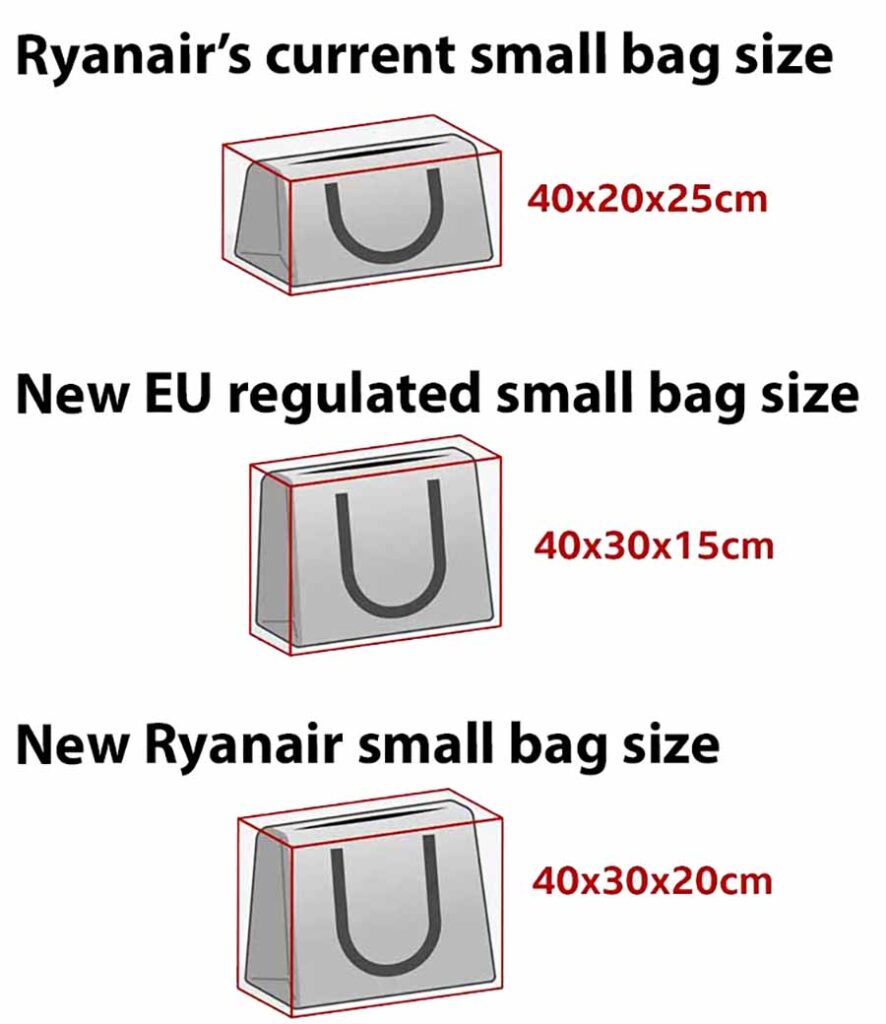A proposed overhaul of EU regulations on cabin baggage has ignited a fierce debate between consumer advocates and airlines, with new rules aimed at standardising allowances and eliminating extra fees for carry-on luggage.
‘Ten centimetres wider’ – Ryanair’s new small bag policy explained
The proposal, voted on by the European Parliament’s Transport and Tourism Committee in June 2025, still requires approval from 55pc of EU member states and is under negotiation. Five airlines currently have under-seat bag allowances smaller than 40x30x15 cm, Aer Lingus, Austrian, Brussels, Lufthansa and Swiss. Airlines currently have a jumble of different bag size allowances:
- Aer Lingus cabin bag allowance: One under-seat bag (25x33x20 cm, no weight limit specified) and one cabin bag (55x40x24 cm, max 10 kg). The under-seat bag is considerably smaller than the EU standard. The larger cabin bag is subject to a €10 charge for being brought on board but is free if checked in to the hold. On Aer Lingus Regional, which uses ATR-72 aircraft, while the mother fleet uses Airbus 320 family, the larger cabin bag size (33x28x20) and weight (max 7kg) allowances are smaller but the personal item size is currently the same.
- Air France cabin bag allowance: One personal item (40x30x15 cm) and one cabin bag (55x35x25 cm), with a combined weight limit of 12 kg. The personal item exactly matches the EU standard, making it fully compliant. The larger cabin bag exceeds the EU standard and may require additional fees if the EU rule is enforced.
- Austrian Airlines cabin bag allowance: One personal item (40x30x10 cm, max 4 kg) and one cabin bag (55x40x23 cm, max 8 kg). The personal item is smaller in depth (10 cm vs. 15 cm) than the EU standard, so it complies but offers less space. The larger cabin bag exceeds the EU standard and may incur fees.
- British Airways cabin bag allowance: One personal item (40x30x15 cm, no weight limit specified) and one cabin bag (56x45x25 cm, max 23 kg). The personal item exactly matches the EU standard, making it fully compliant. The larger cabin bag significantly exceeds the EU standard and may require fees if the EU rule is adopted, though BA’s generous policy already exceeds the proposed two-bag allowance.
- Brussels Airlines cabin bag allowance: One personal item (40x30x10 cm, no weight limit specified) and one cabin bag (55x40x23 cm, max 8 kg). The personal item is smaller in depth (10 cm vs. 15 cm) than the EU standard, so it complies but is less spacious. The larger cabin bag exceeds the EU standard and may incur fees.
- easyJet cabin bag allowance: One under-seat bag (45x36x20 cm, max 15 kg). A larger cabin bag (56x45x25 cm, max 15 kg) is allowed with additional fees or specific fares. The free under-seat bag exceeds the EU standard in all dimensions, offering more space. If the EU standard is enforced, easyJet’s current policy would comply, but the larger bag may still incur fees.
- Finnair cabin bag allowance: One personal item (40x30x15 cm) and one cabin bag (55x40x23 cm), with a combined weight limit of 8 kg (except Economy Superlight fare). The personal item exactly matches the EU standard, making it fully compliant. The larger cabin bag exceeds the EU standard and may require fees under the new rule.
- Iberia cabin bag allowance: One personal item (40x30x15 cm, no weight limit specified) and one cabin bag (56x40x25 cm, max 10 kg). The personal item exactly matches the EU standard, making it fully compliant. The larger cabin bag exceeds the EU standard and may incur fees.
- ITA Airways cabin bag allowance: One cabin bag (55x35x25 cm, max 8 kg) and one personal item (no specific dimensions provided, but typically fits under the seat). Specific personal item dimensions are unavailable, but ITA’s policy likely aligns with similar airlines (e.g., 40x30x15 cm). The larger cabin bag exceeds the EU standard and may incur fees. Check ITA’s website for confirmation.
- KLM cabin bag allowance: One personal item (40x30x15 cm) and one cabin bag (55x35x25 cm), with a combined weight limit of 12 kg. The personal item exactly matches the EU standard, making it fully compliant. The larger cabin bag exceeds the EU standard and may require fees.
- Lufthansa cabin bag allowance: One personal item (40x30x10 cm, max 4 kg) and one cabin bag (55x40x23 cm, max 8 kg). The personal item is smaller in depth (10 cm vs. 15 cm) than the EU standard, so it complies but offers less space. The larger cabin bag exceeds the EU standard and may incur fees.
- Norwegian Air Shuttle cabin bag allowance: One personal item (38x20x30 cm and one cabin bag (55x40x23 cm, max 10 kg), no weight limit specified). The personal item is smaller in width but larger in depth, making it non-compliant with the EU standard unless adjusted. The larger cabin bag exceeds the EU standard and may incur fees.
- Ryanair cabin bag allowance: One small personal bag (40x20x25 cm, no weight limit specified). A larger cabin bag (55x40x20 cm, max 10 kg) is allowed with Priority Boarding or additional fees. The free personal bag exceeds the EU standard in depth (25 cm vs. 15 cm), offering more space. Ryanair has agreed to adopt a larger free bag size, 40x30x20 cm. The larger cabin bag exceeds the EU standard and will likely incur fees.
- SAS (Scandinavian Airlines) cabin bag allowance: One personal item (40x30x15 cm, no weight limit specified and one cabin bag (55x40x23 cm, max 8 kg). The personal item exactly matches the EU standard, making it fully compliant. The larger cabin bag exceeds the EU standard and may require fees.
- Swiss cabin bag allowance: One personal item (40x30x10 cm, no weight limit specified) and one cabin bag (55x40x23 cm, max 8 kg). The personal item is smaller in depth (10 cm vs. 15 cm) than the EU standard, so it complies but is less spacious. The larger cabin bag exceeds the EU standard and may incur fees.
- TAP Air Portugal cabin bag allowance: One personal item (40x30x15 cm, max 2 kg) and one cabin bag (55x40x20 cm, max 8 kg). The personal item exactly matches the EU standard, making it fully compliant. The larger cabin bag exceeds the EU standard and may require fees.
- Turkish Airlines cabin bag allowance: One personal item (40x30x15 cm, max 2 kg) and none cabin bag (55x40x23 cm, max 8 kg). The personal item exactly matches the EU standard, making it fully compliant. The larger cabin bag exceeds the EU standard and may require fees.
- Vueling cabin bag allowance: One under-seat bag (40x20x30 cm, no weight limit specified). A larger cabin bag (55x40x20 cm, max 10 kg) is included with TimeFlex fare or available for a fee. The under-seat bag exceeds the EU standard in depth (30 cm vs. 15 cm), offering more space. The larger cabin bag exceeds the EU standard and may incur fees.
- Wizz Air cabin bag allowance: One under-seat bag (40x30x20 cm, max 10 kg). A larger cabin bag (55x40x23 cm, max 10 kg) is allowed with WIZZ Priority or additional fees. The under-seat bag exceeds the EU standard in depth (20 cm vs. 15 cm), offering more space. The larger cabin bag exceeds the EU standard and will likely incur fees.
The European Parliament’s push for fairer and more transparent travel policies has met resistance from budget airlines, who warn that the changes could spell the end of low-cost flights.
As negotiations continue, travellers across the EU are left wondering how their future journeys might be affected.In June 2025, EU lawmakers voted to ban airlines from charging additional fees for carry-on luggage, proposing that passengers should be entitled to bring one cabin bag weighing up to 7kg and measuring no more than 100cm in total dimensions (length + width + height), alongside a smaller personal item (up to 40x30x15cm) that fits under the seat, free of charge.
The measure, championed by Matteo Ricci, vice-president of the EU Committee on Transport and Tourism, is part of a broader 2023 proposal to strengthen passenger rights. Ricci hailed the vote as “an important step toward fairer and more transparent travel,” arguing that free hand luggage is a “fundamental right” to avoid unjustified costs.
The proposed rules, which would apply to all flights within the EU and to or from the EU—including those involving UK passengers on EU-based airlines like Ryanair, EasyJet, and Wizz Air—aim to address long-standing passenger frustration over inconsistent baggage policies. Currently, airlines set their own limits, leading to confusion.

Ryanair has increased it a free underseat bag of 40x20x25cm to allow one ten centimetres wider 40x30x25cm (but five centimeter shallower), while EasyJet allows a more generous 45x36x20cm. Consumer groups, such as the European Consumer Organisation (BEUC), have criticised these discrepancies, with some countries like Spain already attempted to fine four airlines €179m for “abusive” practices (overturned on appeal), including charging for hand luggage.
The airline industry has hit back, arguing that the proposals threaten the low-cost model that has made air travel accessible to millions. Ryanair, a vocal opponent, insists its policy of allowing one free small bag complies with EU law and keeps fares low.
Forcing airlines to include larger carry-on bags in basic fares would “reduce choice and drive up air fares for all passengers,” the airline warned. Airlines for Europe, the industry’s largest trade body, echoed this sentiment, stating that charging for baggage allows passengers to “choose the exact services that best suit their needs.”
Critics also highlight practical concerns, noting that aircraft cabins lack space for every passenger to bring a 7kg bag, with a typical plane offering only enough overhead storage for 90 trolley bags despite seating 180 passengers.
The proposal has also drawn mixed reactions on social media. Posts on X reflect excitement among some travellers, with one user calling it a “big win for EU travellers” for promoting fairness. However, others warn of unintended consequences, with airlines potentially raising ticket prices to offset lost baggage revenue. One X post suggested Ryanair might reduce its free baggage allowance in response, citing a “backfiring” of the EU’s standardisation efforts.
Beyond baggage, the EU’s reforms include measures to ensure children under 12 are seated with an accompanying adult for free and to provide better protections for passengers with reduced mobility, such as free travel for an accompanying person. A standardised EU-wide compensation form for disruptions is also proposed to streamline claims.
Despite the enthusiasm, the rules are not yet law. The proposal requires approval from 55pc of EU member states, representing 65pc of the EU population, with negotiations set to begin in July 2025. Airline lobbies are expected to resist fiercely, and some analysts predict implementation could be delayed beyond mid-2025.
For now, travellers are advised to check airline policies carefully. A “one-size-fits-all approach” to baggage rules would simplify travel, but until the rules are finalised, passengers must navigate the current patchwork of policies. As the debate unfolds, the promise of free cabin bags hangs in the balance, with the potential to reshape air travel—or drive up costs for all.





